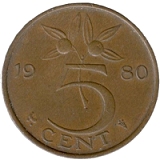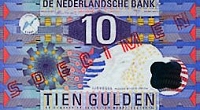|


The Dutch guilder (Dutch: gulden, IPA: [ˈɣʏldən]; sign: ƒ or fl.) was the currency of the Netherlands from the 17th century until 2002, when it was replaced by the euro. Between 1999 and 2002, the guilder was officially a "national subunit" of the euro. However, physical payments could only be made in guilder, as no euro coins or banknotes were available. Guilders are still in use in the Netherlands Antilles, a Dutch dependency, although this currency is distinct from the Dutch guilder. In 2004, the Surinamese guilder was replaced by the Surinamese dollar.
The Dutch name gulden was a Middle Dutch adjective meaning "golden",[1] and the name indicates the coin was originally made of gold. The symbol ƒ or fl. for the Dutch guilder was derived from another old currency, the florijn, called the florin in English.
The exact exchange rate, still relevant for old contracts and for exchange of the legacy currency for euros at the central bank, is 2.20371 Dutch guilders (NLG) for 1 euro (EUR). Inverted, this gives EUR 0.453780 for NLG 1.
History
The first guilder, a 10.61g .910 silver coin, was minted by the States of Holland and West Friesland in 1680. The original guilder design featured Pallas Athena standing, holding a spear topped by a hat in her right hand, resting with her left forearm on Gospels set on an ornate basis, with a small shield in the legend. This guilder was divided into 20 stuivers, each of 8 duiten or 16 penningen. The guilder gradually replaced other silver coin denominations circulating in the United Netherlands - florijn (28 stuivers), daalder (1½ guilders or 30 stuivers), rijksdaalder (2½ guilders or 50 stuivers), silver ducat (2½ guilders or 50 stuivers) and the silver rider ducaton (3 guilders or 60 stuivers).
Between 1810 and 1814, the Netherlands was annexed to France and the French franc circulated. After the Napoleonic wars, the Kingdom of the Netherlands readopted the guilder. In 1817 it became decimalised, with one guilder equal to 100 cents. However, it was not until the 1840s that the last pre-decimal coins (many of which dated back to the 17th century) were withdrawn from circulation, whilst some of the new, decimal coins continued to bear nicknames based on their values in the older currency system through to the 21st century. Until 1948, the plural of cent used on coins was centen, after that it was cent.
The Netherlands was initially on a bimetallic standard, with the guilder equal to 605.61 milligrams of fine gold or 9.615 grams of fine silver. In 1840, the silver standard was adjusted to 9.45 grams, with the gold standard suspended in 1848. In 1875, the Netherlands adopted a gold standard with 1 guilder equal to 604.8 milligrams of fine gold. The gold standard was suspended between 1914 and 1925 and was abandoned in 1936.
Following the German occupation, on 10 May 1940, the guilder was pegged to the Reichsmark at a rate of 1 guilder = 1.5 Reichsmark. This rate was reduced to 1.327 on 17 July of the same year. The liberating Allied forces set an exchange rate of 2.652 guilders = 1 U.S. dollar, which became the peg for the guilder within the Bretton Woods system. In 1949, the peg was changed to 3.8 guilders = 1 dollar, approximately matching the devaluation of the British pound. In 1961, the guilder was revalued to 3.62 guilders = 1 dollar, a change approximately in line with that of the German mark. Since 1967 guilders were made from nickel instead of silver.
In 2002 the guilder was replaced by the euro. Coins remained exchangeable for euros at branches of the Netherlands Central Bank until 1 January 2007. Banknotes valid at the time of conversion to the euro may still be exchanged there until 1 January 2032.
Coins
In the 18th century, coins were issued by the various provinces. There were copper 1 duit, silver 1, 2, 6 and 10 stuivers, 1 and 3 guilder, ½ and 1 rijksdaalder and ½ and 1 ducaton. Gold 1 and 2 ducat trade coins were also minted. Between 1795 and 1806, the Batavian Republic issued coins in similar denominations to the earlier provincial issues. The Kingdom of Holland minted silver 10 stuiver, 1 florin and 1 guilder (equivalent), 50 stuivers and 2½ guilder (also equivalent) and 1 rijksdaalder, along with gold 10 and 20 guilder. Before decimalisation, the Kingdom of the Netherlands briefly issued some 1 rijksdaalder coins.
The Gold 1 and 2 Ducat and Silver Ducat (rijksdaalder) are still minted today as bullion coins.
In 1817, the first coins of the decimal currency were issued, the copper 1 cent and silver 3 guilder. The remaining denominations were introduced in 1818. These were copper ½ cent, silver 5, 10 and 25 cents, ½ and 1 guilder, and gold 10 guilder. In 1826, gold 5 guilder coins were introduced.
In 1840, the silver content of the coinage was reduced (see above) and this was marked by the replacement of the 3 guilder coin by a 2½ guilder piece. The gold coinage was completely suspended in 1853, five years after the suspension of the gold standard. By 1874, production of silver coins greater in value than 10 cents had ceased, to be only fully resumed in the 1890s. Gold 10 guilder coins were struck again from 1875. In 1877, bronze 2½ cent coins were introduced. In 1907, silver 5 cent coins were replaced by cupro-nickel pieces. In 1912, gold 5 guilder coins were reintroduced but the gold coinage was ended in 1933.
In 1941, following the German occupation, production of all earlier coin types ceased and zinc coins were introduced for 1, 2½, 5, 10 and 25 cents. Large quantities of pre-war type, silver 10 and 25 cents and 1 guilder coins were minted in the United States between 1943 and 1945 for use following liberation.
In 1948, bronze 1 and 5 cents and nickel 10 and 25 cents were introduced. These were followed by reduced size, silver 1 and 2½ guilders in 1954. Nickel 1 and 2½ guilder coins were introduced in 1967 and 1969, respectively. In 1983, the 1 cent coin was demonetised whilst bronze clad nickel 5 guilder coins were introduced in 1987, although the banknote could be used until 1995.
At the time of withdrawal, the following denominations of coins were circulating:
- 5 cent - stuiver
- 10 cent - dubbeltje ("doubler" - because its value was two stuivers.)
- 25 cent - kwartje ("little quarter")
- 1 guilder - gulden, colloquially piek
- 2½ guilder - rijksdaalder, colloquially riks or knaak
- 5 guilder - vijfje ("fiver")
All the coins carried a profile image of the Queen on the obverse and a simple grid on the other side. The 1 guilder, 2½ gilder, and 5 guilder coins had 'God zij met ons' ('God be with us') inscribed on the edge.
Banknotes
Between 1814 and 1838, the Netherlands Bank issued notes in denominations of 25, 40, 60, 80, 100, 200, 300, 500 and 1000 guilders. These were followed, from 1846 by state notes (muntbiljetten) in denominations of 5, 10, 20, 50, 100, 500, 1000 guilders, with the 10 and 50 guilders issued until 1914.
In 1904, the Netherlands Bank recommenced the issuance of paper money. By 1911, it was issuing notes for 10, 25, 40, 60, 100, 200, 300 and 1000 guilders. In 1914, the government introduced silver notes (zilverbonnen) for 1, 2½ and 5 guilder. Although the 5 guilder were only issued that year, the 1 guilder notes continued until 1920 and the 2½ guilder until 1927.
In 1926, the Netherlands Bank introduced 20 guilder notes, followed by 50 guilder in 1929 and 500 guilder in 1930. These introductions followed the cessation of production of the unusual 40, 60 and 300 guilder notes during the 1920s.
In 1938, silver notes were reintroduced for 1 and 2½ guilders. During the Second World War, the Netherlands Bank continued to issue paper money, although there were some design changes, most notably, the replacement of a portrait of Queen Emma by a Rembrandt portrait on the 10 guilder note. The Allies printed state notes dated 1943 for use following liberation. These were in denominations of 1, 2½, 10, 25, 50 and 100 guilders. More state notes were issued for 1 and 2½ guilders in 1945 and 1949.
Following the war, the Netherlands Bank introduced notes for 10, 20, 25, 50, 100 and 1000 guilders. The last 20 guilder notes were dated 1955, whilst 5 guilder notes were introduced in 1966 (replaced by coins in 1987) and 250 guilder in 1985.
At the time of withdrawal, the following denominations of banknotes were circulating:
- ƒ10 - tientje ("little ten", see Diminutive), joet
- ƒ25 - geeltje (yellow one)
- ƒ50 - zonnebloem (sunflower)
- ƒ100 - honderdje, meier / later: snip (common Snipe)
- ƒ250 - vuurtoren (lighthouse)
- ƒ1000 - duizendje, (rooie) rug (red back) / rooi(tj)e
At the time of withdrawal, all but the 50 and 250 guilder notes had been issued in a new series that was the same colour as the older, long-serving notes but with a mostly abstract pattern, featuring a different bird for each denomination.
Persons depicted on older banknotes were:
- ƒ5 - poet Joost van den Vondel (until 1988, when the note was replaced by a ƒ 5 coin)
- ƒ10 - painter Frans Hals
- ƒ25 - composer Jan Petersz. Sweelinck
- ƒ100 - admiral Michiel de Ruyter(This being the most profitable note to counterfeit it was first replaced by a note featuring the common snipe. This note was of a similar design as the newly introduced 50 and 250 guilder notes; and was again replaced by an abstract design in the last series of guilder notes)
- ƒ1000 - philosopher Baruch de Spinoza
These 1970s "face"-notes and the 80's ƒ50 (sunflower), ƒ100 (snipe) and ƒ250 (lighthouse) were designed by R.D.E. Oxenaar. Eventually all faces were to be replaced by abstracts, designed by Jaap Drupsteen, .
Name in Chinese
The Chinese translation for "florin" and consequently "guilder" is (pinyin: dùn; literally shield) originated from the translation referring to the British florin with its four shields in the 1849 design. This translation was then borrowed to refer similarly to the Dutch florin and guilder.
The text on this page has been made available under the Creative Commons Attribution-ShareAlike License and Creative Commons Licenses
|
